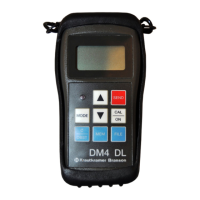Krautkramer DM4E / DM4 / DM4 DL Issue 05, 01/01 1-9
Important remarks about thickness testing Introduction
Interfaces within the test object can completely reflect
the sound beam so that deeper reflection positions,
e.g. backwall of the test object, can no longer be
reached by the sound beam. Therefore it must be en-
sured that the area to be tested is able to be covered
by the sound beam.
Ultrasonic thickness measurement
Each thickness measurement with ultrasonics is
based on a time of flight measurement of the sound
pulse in the test object. The condition for exact mea-
surement results is therefore a constant sound veloc-
ity in the test object. Normally this condition is fulfilled
with steel objects, even with different alloy contents.
The sound velocity changes so little that it is only no-
ticeable with precision measurements. In other materi-
als, e.g. nonferrous heavy metal or plastics, the sound
velocity is subject to greater changes. Due to this, the
measurement accuracy can be effected.
Influence of the test material
If the material is not homogeneous different sound
velocities can exist in various areas of the test object.
Therefore an average sound velocity is to be taken
into account when calibrating the instrument.
The best results are however achieved when the in-
strument is calibrated on a reference block made of
the same material as the test object. This calibration
block should have plane-parallel surfaces and have a
thickness which corresponds to the thickness of the
test object. In addition to this, the operator should un-
derstand that changes to the sound velocity occur
when material is heat treated. This must be taken into
account with the evaluation of the thickness accuracy
measured by the instrument.
If substantial sound velocity changes are to be reck-
oned with then the instrument calibration should be
made at shorter intervals to the existing sound veloc-
ity. If this is not made, wrong thickness readings will
occur.
Krautkramer DM4E / DM4 / DM4 DL Issue 05, 01/01 1-9
Important remarks about thickness testing Introduction
Interfaces within the test object can completely reflect
the sound beam so that deeper reflection positions,
e.g. backwall of the test object, can no longer be
reached by the sound beam. Therefore it must be en-
sured that the area to be tested is able to be covered
by the sound beam.
Ultrasonic thickness measurement
Each thickness measurement with ultrasonics is
based on a time of flight measurement of the sound
pulse in the test object. The condition for exact mea-
surement results is therefore a constant sound veloc-
ity in the test object. Normally this condition is fulfilled
with steel objects, even with different alloy contents.
The sound velocity changes so little that it is only no-
ticeable with precision measurements. In other materi-
als, e.g. nonferrous heavy metal or plastics, the sound
velocity is subject to greater changes. Due to this, the
measurement accuracy can be effected.
Influence of the test material
If the material is not homogeneous different sound
velocities can exist in various areas of the test object.
Therefore an average sound velocity is to be taken
into account when calibrating the instrument.
The best results are however achieved when the in-
strument is calibrated on a reference block made of
the same material as the test object. This calibration
block should have plane-parallel surfaces and have a
thickness which corresponds to the thickness of the
test object. In addition to this, the operator should un-
derstand that changes to the sound velocity occur
when material is heat treated. This must be taken into
account with the evaluation of the thickness accuracy
measured by the instrument.
If substantial sound velocity changes are to be reck-
oned with then the instrument calibration should be
made at shorter intervals to the existing sound veloc-
ity. If this is not made, wrong thickness readings will
occur.

